Basis of Classification
Basis of classification in Animals
Despite differences in structure and shape across animals, there are essential similarities in cell organization, body symmetry, coelom type, and digestive, circulatory, and reproductive system patterns. These characteristics are used to classify animals, and some of them are covered here. The requirement for classification grows in importance as more than a million species of animals have been described to date. Newly described species can also be assigned a systematic position thanks to categorization.
A. Level of organization: Even though all members of Animalia are multicellular, they do not all have the same cell organization pattern. Sponge cells, for example, are grouped as loose cell aggregates, indicating that they have a cellular level of organization. Among the cells, there is some division of labour (activities). The cell arrangement in coelenterates is more complicated. The cells that perform the same function are grouped together ies, which is referred to as the tissue level of organization. Members of the Platyhelminthes and other higher phyla have an even higher degree of organization, namely the organ level, in which tissues are gathered together to form organs, each specialized for a certain function. Organs have come together to form functional systems in creatures including Annelids, Arthropods, Molluscs, Echinoderms, and Chordates.
B. Symmetry: The symmetry of animals can be used to classify them. Sponges are generally asymmetrical, which means that any plane passing through the centre split them in half evenly. Radial symmetry occurs when any plane traveling through the body's central axis divides the organism into two identical halves. This is the body plan of coelenterates, ctenophores, and echinoderms. Bilateral symmetry is found in animals such as annelids, arthropods, and others whose bodies can be divided into identical left and right halves in just one plane.
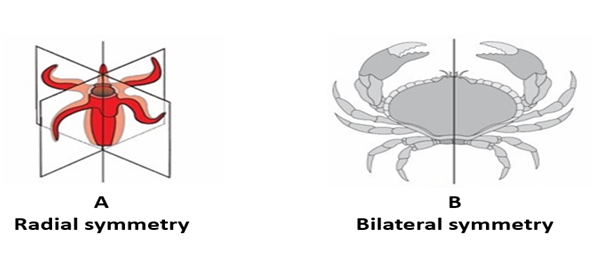
C. Germinal layers: During embryonic development, a germ layer is the first layer of cells that arises. Gastrulation is the process through which an early embryo develops three germ layers. Ectoderm, endoderm, and mesoderm are the three types of cellular layers that make up the body. Diploblastic creatures, such as coelenterates, have their cells organized in two embryonic layers, external ectoderm, and an internal endoderm. Between the ectoderm and the endoderm, there is an undifferentiated layer called mesoglea. Triploblastic animals are those in which the growing embryo has a third germinal layer, mesoderm, between the ectoderm and endoderm.
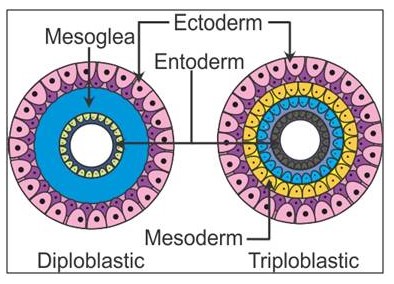
D.Coelom: When it comes to classification, the presence or absence of a cavity between the body wall and the gut wall is crucial. The coelom is the name for the bodily cavity that is lined by mesoderm. Coelomates are animals that have a coelom, such as annelids, mollusks, arthropods, echinoderms, hemichordates, and chordates. Mesoderm does not line the body cavity of some animals; instead, it appears as scattered pouches in between the ectoderm and endoderm. Pseudocoelom is the name for such a bodily cavity, and animals with them are known as pseudocoelomates, such as aschelminthes. Acoelomates, such as Platyhelminthes, are animals that do not have a body cavity.
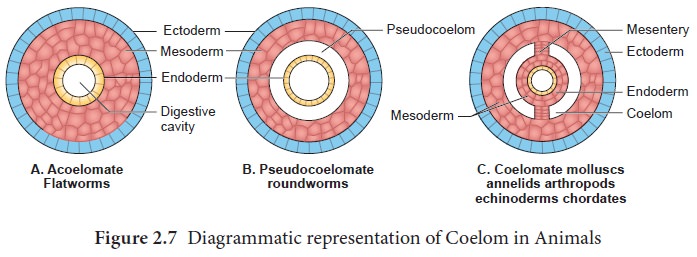
E. Segmentation: The body of several animals is divided into segments both visibly and internally, with at least some organs repeating serially. The body of an earthworm, for example, displays a pattern known as metameric segmentation, and the phenomenon is known as metamerism.
F. Notochord: In some animals, the notochord is a mesodermally derived rod-like structure that forms on the dorsal side during embryonic development. Chordates are creatures that have a notochord, while non-chordates are animals that do not have one, such as Porifera and Echinoderms.
The broad classification of Animalia is based on common fundamentalfeatures as discussed above. A schematic diagram for the same is given below.
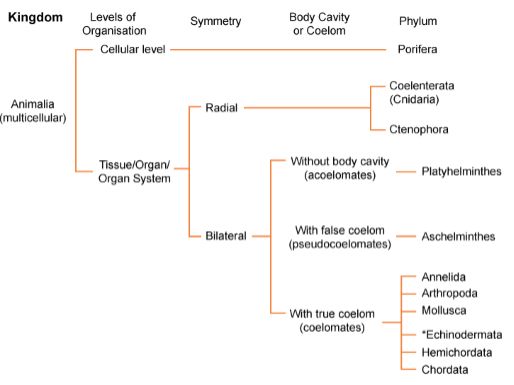
Phylum : Porifera
Phylum Porifera
This animal group comprises Sponges and is thought to be the oldest on the planet. Sponges are the most basic multicellular creatures. They don't have any tissues or organs, despite being multicellular. Sponges need to be near water, thus they dwell in an aquatic environment. Water is essential for nutrient absorption, gas exchange, and excretion. The sponges' bodies have numerous holes or pores known as Ostia. Sponge bodies are built so that water can circulate through them, filtering out food and absorbing dissolved oxygen while also removing waste.This phylum of organisms lacks a specialized digestive, neurological, or circulatory system. Instead, they have a canal or water transport system that performs the activities of digesting, excretion, and gas exchange.
Their bodies are asymmetrical, and their design has been optimized to facilitate the most efficient flow of water via the core hollow that is present inside. Bacteria and other food particles found in the water are their main sources of nutrition. The spongocoel is a huge central hollow canal in their bodies. Water enters the spongocoel through the Ostia and exits through the osculum. Choanocytes or collar cells, with their flagellum jutting out, line up the spongocoel and canals.The water is moved throughout the sponge's body by the beating of this flagellum from all choanocytes. Common examples areSycon (Scypha), Spongilla (Freshwatersponge), and Euspongia(Bath sponge).
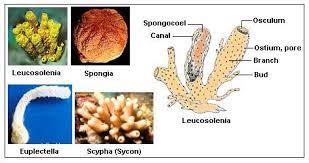
Phylum : Coelenterata (Cnidaria)
Phylum Coelenterata
They are also known by the name Cnidaria. They are radially symmetrical aquatic, primarily marine, sessile, or free-swimming organisms. Typically, these are invertebrate species with a very basic tissue arrangement. Coelenterates can be found in colonies or alone. Coelenterates are the simplest animal group with genuine tissues and the coelenteron or gastrovascular cavity as a distinguishing feature. The word Cnidaria comes from the stinging capsules or nematocysts found on the tentacles and body, which are called Cnidoblasts or Cnidocytes. Cnidoblasts are the phylum Cnidaria's distinguishing trait.They contain stinging capsules called nematocysts. It aids in both prey capture and defence. Cnidoblasts are employed for prey capture, defence, and anchoring. Cnidarians are diploblastic and have tissue-level organization. They have a single aperture in the center of their gastro-vascular cavity, and their mouth is hypostome. Extracellular and intracellular digestion are both involved.The skeleton of some cnidarians, such as corals, is made of calcium carbonate. Polyp and medusa are the two primary body types of cnidarians. The former, like Hydra, Adamsia, and others, are sessile and cylindrical, whereas the latter, like Aurelia or jellyfish, is umbrella-shaped and free-swimming. Cnidarians often show alternation of generations (Metagenesis). When both polyps and medusae exist within a Cnidarian life cycle, polyps reproduce asexually by budding off medusae, and medusae form the polyps sexually (e.g. Obelia). Examples: Physalia (Portuguese man-of-war), Adamsia (Sea anemone), Pennatula (Sea-pen), Gorgonia (Sea-fan), and Meandrina (Brain coral).
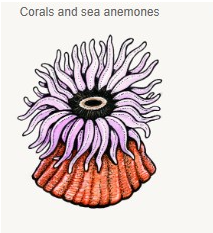
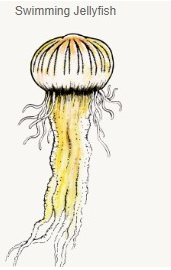
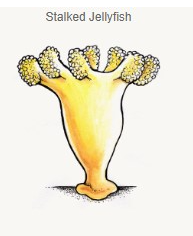
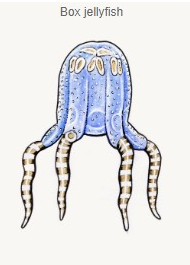
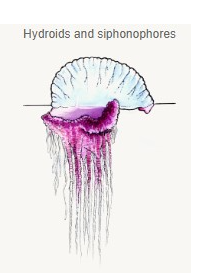
Figure 6: Phylum Cnidaria.
Phylum : Ctenophora
Phylum Ctenophora
Ctenophores, often known as sea walnuts or comb jellies, are biradially symmetrical, diploblastic animals with a tissue-level organization that are entirely marine. The body has eight rows of ciliated comb plates on the outside that aid in movement. The existence of comb plates containing cilia, which are employed for propulsion, distinguishes the phylum. Ctenophores have a more complex body than sponges, although it is less complicated than bilaterians. They have tissue-level organization, just like cnidarians. Extracellular and intracellular digestion both are observed. Ctenophores exhibit a lot of bioluminescence (the ability of a living creature to emit light). They do not have stinging cells. In order to capture prey, ctenophores possess sticky cells called Colloblasts. The sexes are not divided. Sexual reproduction is the only way to reproduce.
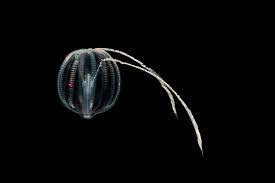
External fertilization is used in conjunction with indirect development.Examples arePleurobrachia and Ctenoplana.
Phylum: Platyhelminthes
Phylum Platyhelminthes
Flatworms and tapeworms are popular names for Platyhelminthes. They are a type of invertebrate with a soft body. In reality, there are over 20,000 different species of these animals. A few of these parasites live on humans and other animals as parasites. Furthermore, because of their parasitic nature, they do cause some discomfort to the host animal. Schistosomiasis, often known asbilharziasis, is a parasitic flatworm disease. A few species in this phylum are known to be major causes of disease. They are triploblastic, acoelomate, and bilaterally symmetrical. Their body is dorsoventrally flattened which is its most noticeable feature. They are flat because the body has no cavities. They also lack specialized systems and do not have segmented bodies. They have no specialized circulatory and respiratory organs, which allows oxygen and nutrients to pass through their bodies by diffusion.Around 80% of the flatworms are parasitic, with a few free-form flatworms thrown in for good measure. Scavengers or predators are the free-living forms. The parasitic species feed on the tissues of the organism they dwell in. Planaria, for example, has a high potential for regeneration. This phylum's animals come in a wide range of sizes. Some are minuscule, while others can reach lengths of up to two feet. They're also hermaphrodites, which means they have both sexes living in the same body.They typically reproduce both sexually and asexually. For instance, Taenia (Tapeworm) and Fasciola (Liver fluke).
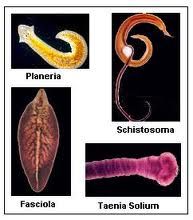
Phylum: Aschelminthes / Nemathelminthes
Phylum Aschelminthes
Roundworms are the popular name for Aschelminthes. They are triploblastic, bilaterally symmetrical, and pseudocoelomates creatures. Aschelminthes can be parasitic or free-living. The free-living creatures, which feed on bacteria, are abundant in soils and sediments. Others are plant parasites that can cause disease in economically significant crops. The remaining parasites can be found in both animals and humans. Hookworms, pinworms (Enterobius), Guinea worms (Dracunculus), and intestinal roundworms are examples of parasitic worms. A well-developed muscular pharynx completes the alimentary canal. Through the excretory hole, an excretory tube transfers body wastes from the body cavity. In most of the Aschelminthes, the respiratory and circulatory systems are absent. They utilize the process of diffusion for the circulation of oxygen. Aschelminthes are dioecious, which means they are separate. Females are frequently taller than males.Internal fertilization occurs, and development can be either direct (the young resemble the adult) or indirect. The Giant Intestinal Roundworm (Ascaris lumbricoides) is an endoparasite that lives in the human gut. They're quite prevalent in kids. Ascariasis is a disease caused by these worms. Many adult roundworms dwell inside the intestine, obstructing the digestive tract.Examples: Ascaris (Roundworm), Wuchereria (Filaria worm), Ancylostoma (Hookworm).

Phylum : Annelida
Phylum Annelida
Phylum Annelida contains around 17000 species. Ringworms and segmented worms are other names for annelids. They can be found in a variety of habitats, including coastal waterways, freshwater, and wet terrestrial places. The annelids can be as small as a few centimeters long or as large as three meters. In addition, some species in this phylum have unusual forms and vibrant colors. Annelids are invertebrate creatures with bilateral symmetry. They are triploblastic and coelomate. Their body surface is divided by segments called metameres. They have longitudinal and circular muscles that let them move around. Nereis and other aquatic annelids have lateral appendages called parapodia that aid in swimming.There is a closed circulatory system in place. Osmoregulation and excretion are aided by nephridia (sing. nephridium). The neural system is made up of paired ganglia (sing. ganglion) coupled to a double ventral nerve cord via lateral nerves. Earthworms and leeches are monoecious, but Nereis, an aquatic variety, is dioecious. Sexual reproduction is prevalent. Nereis,Pheretima (Earthworm), and Hirudinaria are other examples (Bloodsucking leech).
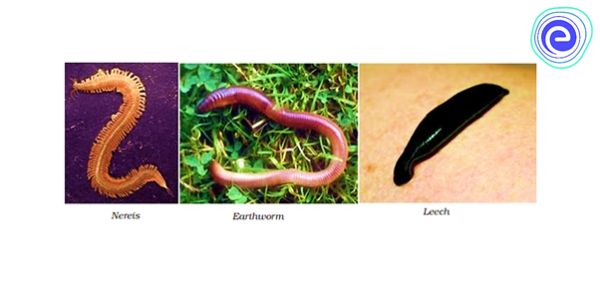
Phylum : Arthropoda
Phylum Arthropoda
Arthropods are animals with joint legs. Spiders, ants, bees, crabs, shrimps, millipedes, centipedes, and other insects belong to this phylum of the kingdom Animalia. Arthropods make up more than two-thirds of all identified species on the planet. The presence of an exoskeleton, which makes arthropods adaptable, isprotective and allows flexibility and mobility.It is largely responsible for their success and survival. They are organized at the organ-system level. They are coelomate animals that are triploblastic, segmented, and bilaterally symmetrical. Arthropods have a chitinous exoskeleton covering their bodies. The head, thorax, and abdomen make up the arthropod body. Their appendages are joined. Gills, book gills, book lungs, and the tracheal system are examples of respiratory organs.The circulatory system is open. There are sensory organs like antennae, eyes (complex and simple), and statocysts for balance and orientation. Malpighian tubules are used for excretion. The majority of them are dioecious. Internal fertilization is common. The majority of them are oviparous. Direct or indirect development is possible. Apis (Honey bee), Bombyx (Silkworm), and Laccifer(Lac insect)are some examples of commercially important insects. Anopheles, Culex, and Aedes are examples of vectors (Mosquitoes). Limulus (King crab) is known as a living fossil, while Locusta(Locust) is a gregarious pest.
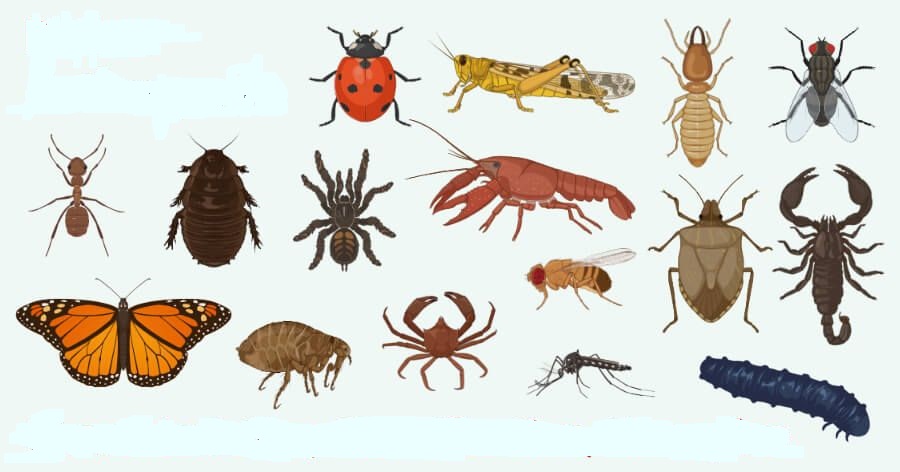
Phylum : Mollusca
Phylum Mollusca
Molluscs are a diverse group of organisms that play a vital role in the global ecology. A calciferous shell is found on many creatures in this phylum. The bodies are usually soft and protected by a hard exoskeleton. They can be found both on land and in the deepest parts of the ocean. This is the second-largest phylum of animals. Molluscs are organ-system-organized terrestrial or aquatic (marine or freshwater) animals. They are animals that are bilaterally symmetrical, triploblastic, and coelomate. A calcareous shell covers the body, which is unsegmented with a distinct head, muscular foot, and visceral hump. Over the visceral hump, a soft and spongy layer of skin forms a mantle.The mantle cavity is the region between the hump and the mantle, and it contains feather-like gills. They have breathing and excretory systems. Sensory tentacles can be found in the anterior head region. The radula, a file-like rasping organ in the mouth, is used for feeding. They are both a food and a jewellery source. The firm shells are used to create stunning jewellery. Even though it sounds strange, these are also raised as pets in some parts of the world. Bivalve and gastropod pearls are particularly valuable because they are lined with nacre. Natural pearls are generated when a small foreign object becomes lodged between the mollusc's mantle and shell.Bivalve molluscs are useful as freshwater and marine bioindicators. However, not all molluscs are beneficial to humans. Snails and slugs, for example, are considered pests.They are usually dioecious and oviparous with indirect development. Examples: Pila (Apple snail), Pinctada (Pearl oyster), Sepia (Cuttlefish), Loligo (Squid), Octopus (Devilfish), Aplysia (Seahare), Dentalium (Tusk shell), and Chaetopleura (Chiton).
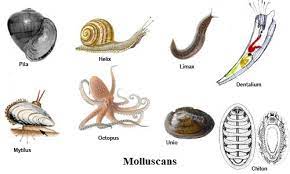
Phylum : Echinodermata
Phylum Echinodermata
Invertebrates with spiny skin are known as echinoderms. The endoskeleton of these creatures is made up of calcareous ossicles. All of them are marine, having organ-system organization. There are no freshwater or terrestrial organisms in this phylum. Adult echinoderms have radial symmetry, whereas larvae have bilateral symmetry. They are coelomate and triploblastic creatures. With the mouth on the bottom (ventral) side and the anus on the upper (dorsal) side, the digestive system is complete. Echinoderms are distinguished by the presence of a water vascular system that aids motility, food capture and transport, and breathing. This system has a central ring canal and radial canals that extend along each arm. Through these structures, water circulates. The madreporite is a structure present on top of the body. This is responsible for the regulation of the water in the water vascular system. There is no excretory system. Sexes are distinct. Reproduce sexually. External fertilization is common. The development of free-swimming larva is indirect. Asterias (starfish), Echinus (sea urchin), Antedon (sea lily), Cucumaria (sea cucumber), and Ophiura (Brittle star) are among examples.
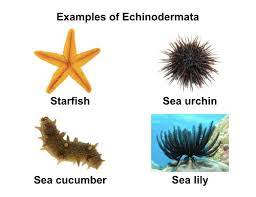
Phylum : Hemichordata / Stomachordata
Phylum Hemichordata
This phylum is made up of marine deuterostome creatures. They are sometimes referred to as the Echinodermata's sister group. Phylum Hemichordata is a small phylum with only 100 recognized species and animals that resemble worms. Some species live alone, while others live in colonies. Hemichordata was previously classified as a sub-phylum of the Chordata phylum. However, because these species lack a post-anal tail or even the notochord, which is a distinguishing trait of chordates, they are now classified as a different phylum under non-Chordata.
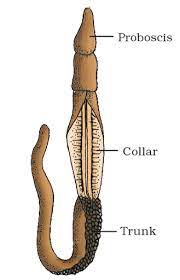
Hemichordates, on the other hand, have a primitive structure comparable to the notochord in the collar region. This phylum is made up of a tiny group of worm-like marine organisms that are organized at the organ-system level.This phylum is made up of marine deuterostome creatures. They are sometimes referred to as the Echinodermata's sister group. Hemichordatesare bilaterally symmetrical and triploblastic animals.The body is divisible into proboscis, collar, and trunk.Simple, open, and well-developed circulatory system is present. The alimentary canal is a straight, complete, or U-shaped tube.Excretion by a single glomerulus situated in the proboscis.Reproduction is mainly sexual. Sexes are usually separate.External fertilization takes place in seawater.Development can be direct or indirect.An important example of a hemichordate is Balanoglossus or acorn worm. Other species are Saccoglossus, Rhabdopleura, Atubaria, and Dendrograptus.
phylum chordata
Phylum Chordata
This is the third most populous phylum in the animal kingdom. The existence of a notochord, a dorsal hollow nerve cord, a post-anal tail, and paired pharyngeal gill slits distinguishes animals belonging to the phylum Chordata. These are bilaterally symmetrical, triploblastic, coelomates that are organized at the organ-system level. Their circulatory system is closed. The Chordata phylum is subdivided into three subphyla:
The Chordata phylum is subdivided into three subphyla:
(a) Urochordata or Tunicata: Examples: Ascidia, Salpa, and Doliolum;
(b) Cephalochordata: Example: Branchiostoma; Amphioxus or Lancelet
(c)Vertebrata: Example: Horse, Humans
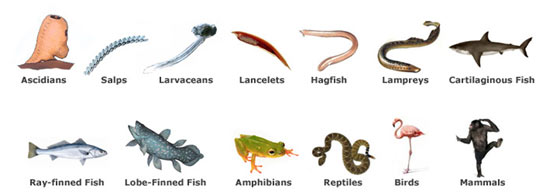
Subphyla Urochordata and Cephalochordata are collectively referred to as protochordate andare only found in the ocean. The notochord is only present in the larval tail of Urochordata, but it extends from the head to the tail area of Cephalochordata and is present throughout their lives.During the embryonic period, members of the Vertebrata subphylum have a notochord. In adulthood, the notochord is replaced by a cartilaginous or bony vertebral column. All chordates are vertebrates, however, not all chordates are vertebrates. Vertebrates have a ventral muscular heart with two, three, or four chambers, kidneys for excretion and osmoregulation, and paired appendages that can be fins or limbs.
The subphylum Vertebrata is further divided as shown below:
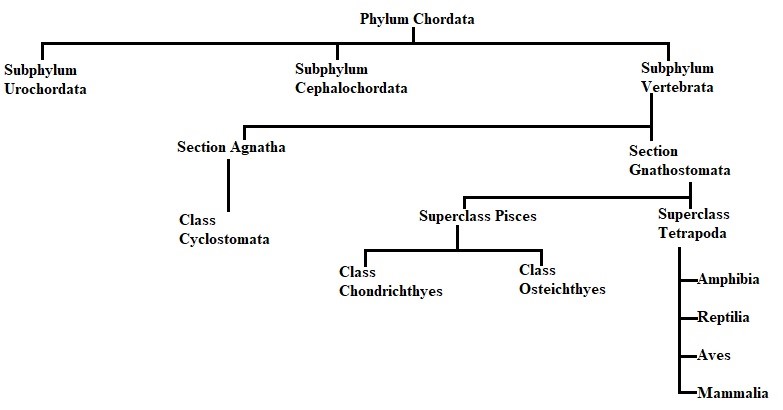
Agnatha comprises jawless organisms which consist of only one subdivision, Cyclostomata. Gnathostomata comprises animals having jaws and can be further divided into fin-bearing Pisces and limb-bearing Tetrapods.
A. Class Cyclostomata: Cyclostomata comprises loving members of the class who are ectoparasiteson some fishes. For respiration, they have an extended body with 6-15 pairs of gill slits. Cyclostomes have a circular sucking mouth with no jaws. Scales are missing from their bodies, and they have paired fins. The cranium and spinal column are made of cartilage. The circulation is closed. Cyclostomes are marine creatures that travel to freshwater to procreate. They die within a few days of spawning. After metamorphosis, their larvae return to the sea. Petromyzon (Lamprey) and Myxine (Hagfish) are two examples.
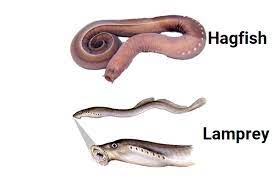
B. Class Chondrichthyes: They are streamlined aquatic organisms with a cartilaginous endoskeleton. The mouth is situated ventrally. The notochord remains throughout life. Gill slits are distinct and lack an operculum (gill cover). The skin is robust and covered in little placoid scales. Teeth are modified placoid scales that point backward. Their jaws are extremely strong. These creatures are predators. They must swim frequently to prevent sinking due to the lack of an air bladder. It has two chambers (one auricle and one ventricle). Some have electric organs (such as Torpedo) and others have poison stings (e.g., Trygon). They are cold-blooded (poikilothermous) animals, meaning they can't control their body temperature. Sexes are distinct. Males have claspers on their pelvic fins.Internal fertilization is present, and many of them are viviparous. Scoliodon(dogfish), Pristis (sawfish), Carcharodon (great white shark), and Trygon(Stingray)are among examples.
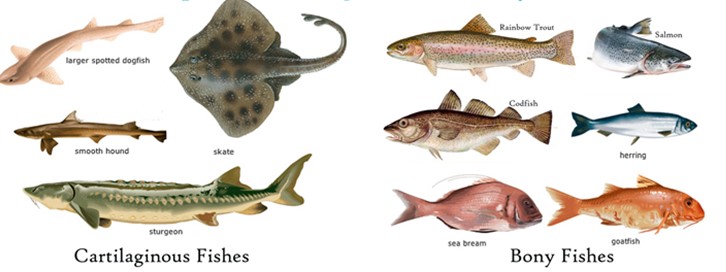
C.Class Osteichthyes: With a bony endoskeleton, it contains both marine and freshwater fish. Their physique is slim. The mouth is primarily terminal. They have four pairs of gills on each side, which are covered by an operculum. Cycloid/ctenoid scales cover the skin. The presence of an air bladder influences buoyancy. A two-chambered heart (one auricle and one ventricle). They're cold-blooded creatures. Sexes are distinct. External fertilization is common. They are generally oviparous and have a straight development. Examples includeFreshwater – Labeo (Rohu), Catla (Katla), Clarias (Magur); Marine – Exocoetus (Flying fish), Hippocampus (Sea horse); Aquarium – Betta (Fighting fish), Pterophyllum(Angelfish).
D. Class Amphibia: Amphibians can survive in both aquatic and terrestrial environments. They all have two sets of limbs. The body is divided into two parts: head and trunk. Some individuals may have a tail. The skin of amphibians is wet (without scales). Eyelids cover the eyes. The ear is represented by a tympanum. The alimentary canal, urinary system, and reproductive tract all open into a single chamber called the cloaca, which is visible from the outside. Gills, lungs, and skin are all used to breathe. There are three chambers in the heart (two auricles and one ventricle). They are cold-blooded creatures. Sexes are distinct. External fertilization is used. They are oviparous and have indirect development. Bufo (toad), Rana (frog), Hyla (tree frog), Salamandra(salamander), and Ichthyophis (Limbless amphibian) are a few examples.
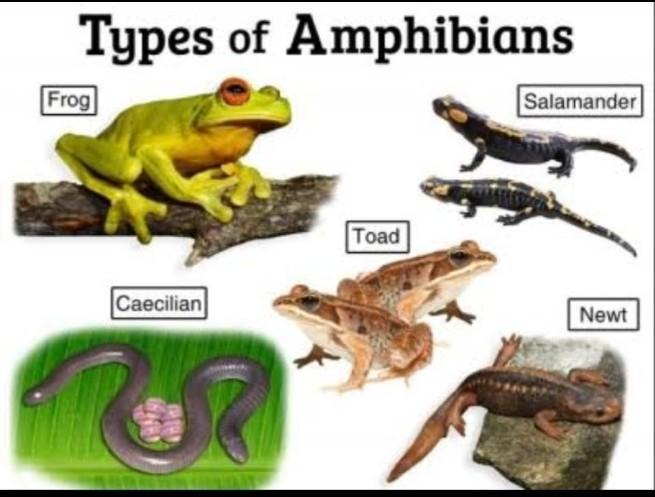
E. Class Reptilia: This class includes organisms having to creep or crawla mode of locomotion. They are generally terrestrial animals with dry, cornified skin, epidermal scales, or scutes covering their bodies. External ear holes are not present. Tympanum stands for the ear. Limbs are two pairs when present. Crocodiles have four chambers in their hearts, which are usually three. Reptiles are Poikilotherms. As skin cast, snakes and lizards shed their scales. Sexes are distinct. Internal fertilisation. They are oviparous and have straight development. Chelone (turtle), Testudo (tortoise), Chameleon (tree lizard), Calotes (garden lizard), Crocodilus (crocodile), and Alligator are just a few examples. Poisonous s.nakes — Naja (Cobra), Bangarus (Krait), Vipera, (Viper) etc. are also known as reptiles.
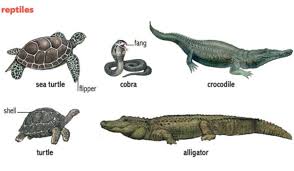
F.Class Aves: The presence of feathers distinguishes Aves (birds), and most of them can fly, except flightless birds (e.g., Ostrich and Emu). They have a beak. The forelimbs have been transformed into wings. Scales cover the hind limbs, which are modified for walking, swimming, and grasping tree branches. Except for the oil gland at the base of the tail, the skin is dry and lacks glands. The long bones are hollow with air spaces, and the endoskeleton is entirely ossified (bony) (pneumatic). The crop and gizzard are extra chambers in the digestive tract of birds. The heart has four chambers in total. They are warm-blooded (homoeothermic) creatures, which means they can keep their body temperature constant. Lungs are used to breathe. Respiration is aided by air sacs attached to the lungs. Sexes are distinct.Internal fertilization is present. They are oviparous and have direct development. Corvus (Crow), Columba (Pigeon), Psittacula (Parrot), Struthio (Ostrich), Pavo (Peacock), Aptenodytes (Penguin), and Neophron (Vulture) are some examples.
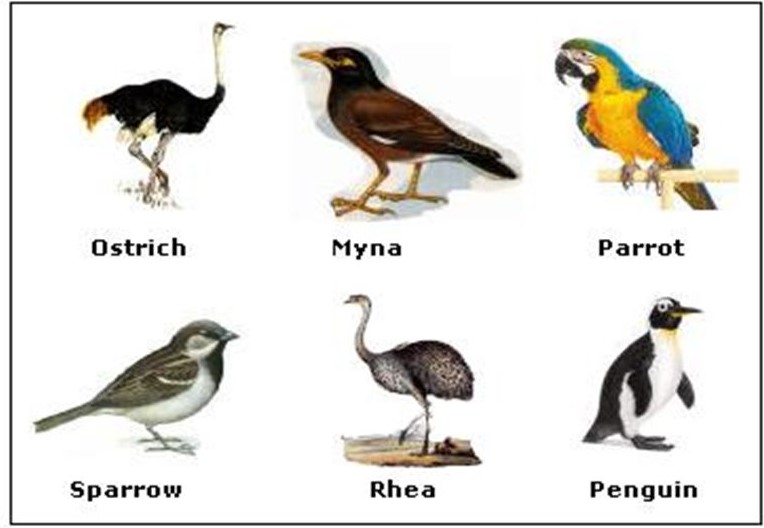
G. Class Mammalia: In the phylum Chordata, Mammalia is the most developed class. Polar ice caps, deserts, mountains, woods, grasslands, and gloomy tunnels are all places where mammals can be found. Some have developed the ability to fly or live in water. The existence of milk-producing glands (mammary glands), which nourish the young, is the most distinguishing mammalian trait. They have two pairs of limbs, one for walking, the other for running, climbing, digging, swimming, and flying. Mammalian skin is remarkable in that it has hair. External pinnae or ears are present. The jaw contains a variety of tooth kinds. The human heart has four chambers. They're the same temperature. Lungs are used to breathe. Sexes are distinct, and fertilization takes place internally.
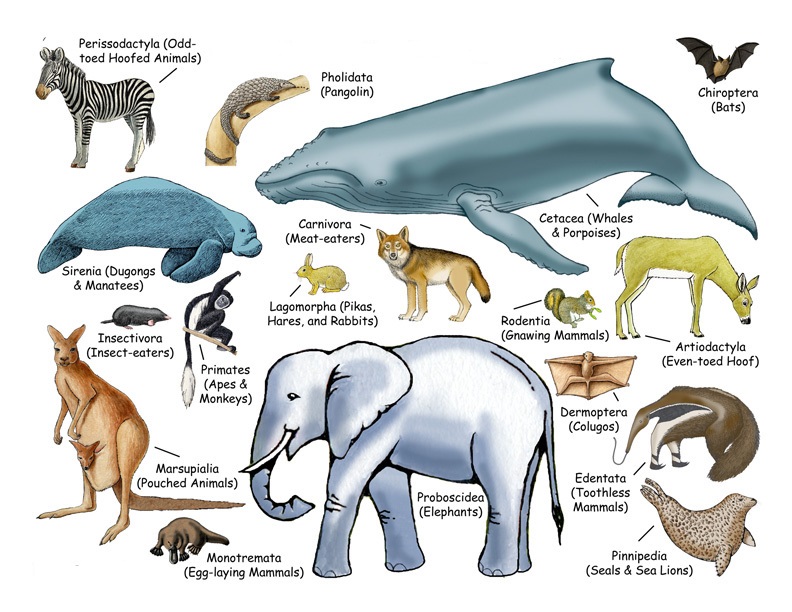
With a few exceptions, they are viviparous and develop directly. Macropus (Kangaroo), Pteropus (Flying fox), Camelus (Camel), Macaca (Monkey), Rattus (Rat), Canis (Dog), Felis (Cat), Elephas (Elephant), Equus (Horse), Delphinus (Common dolphin), Balaenoptera (Blue whale), Panthera tigris (Tiger), Panthera leo (Lion).

 ACME SMART PUBLICATION
ACME SMART PUBLICATION
